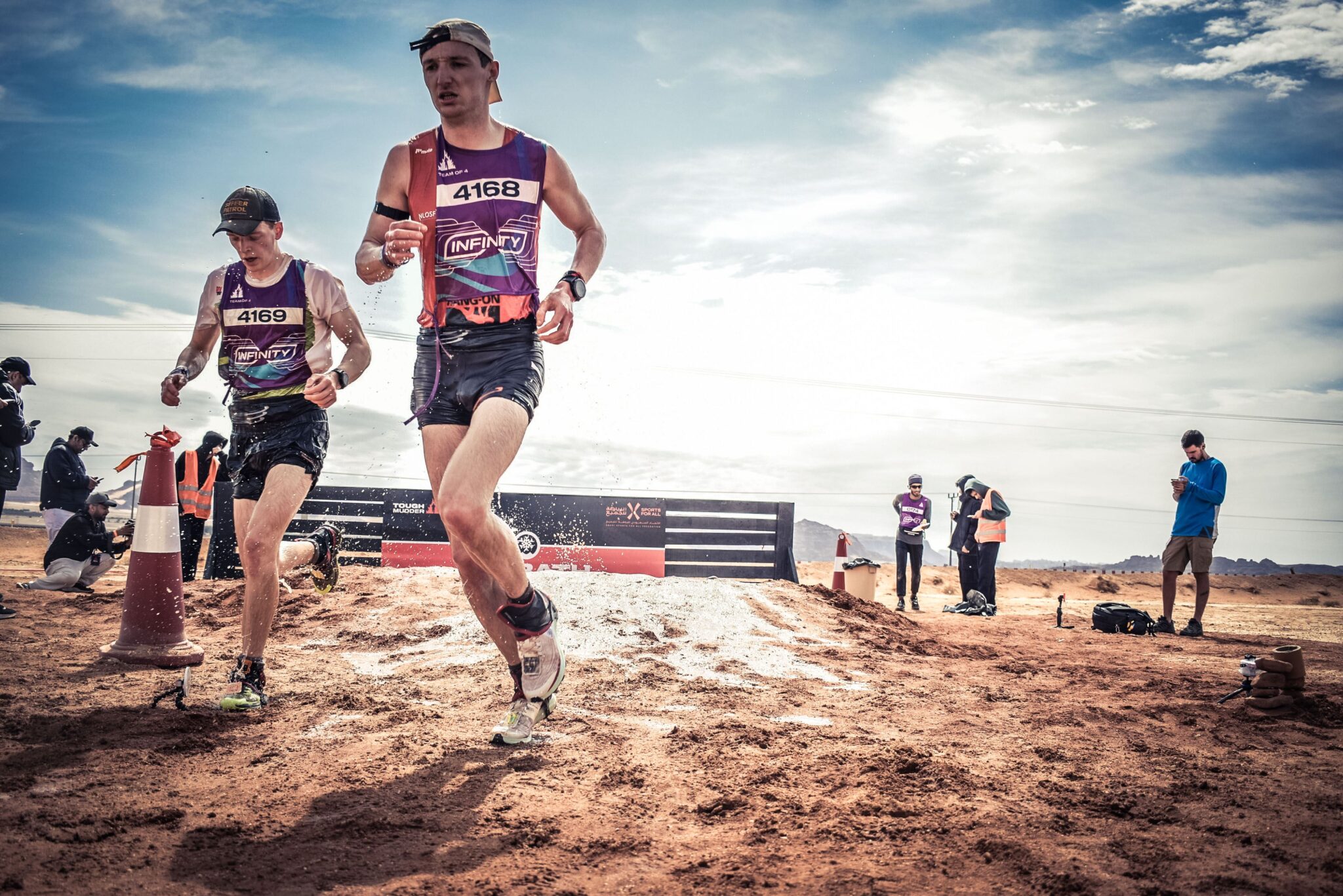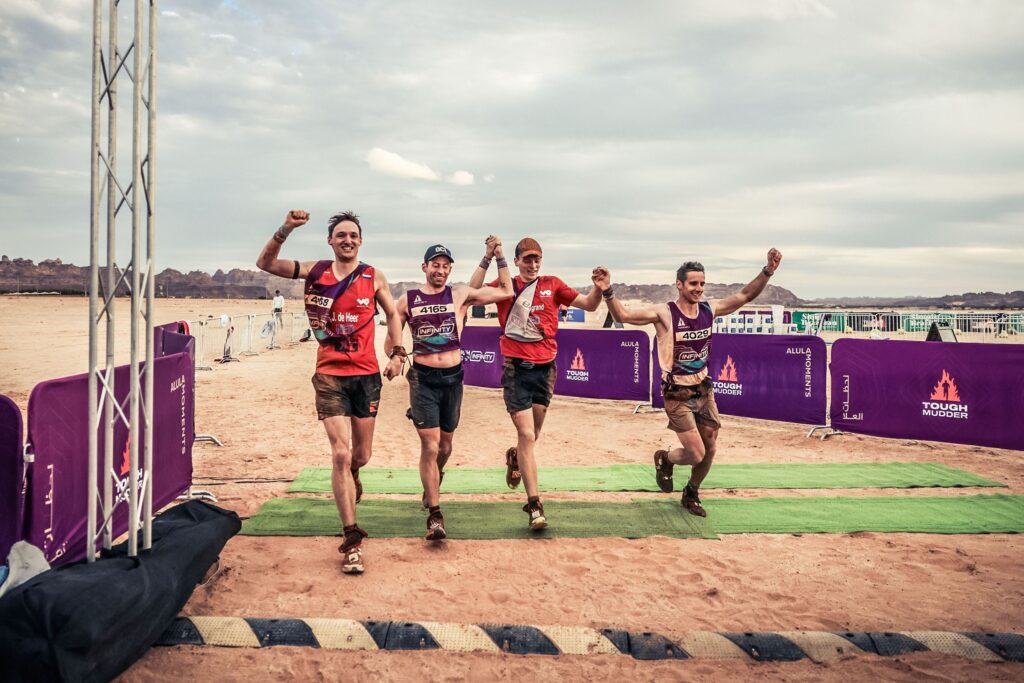It’s mid-December. I receive an invitation on Instagram: whether I am interested in running circles in a desert for 8 hours to compete for one of the largest prize pools in OCR. My first reaction: absolutely not, I have no business there! In the following weeks, however, this race keeps lingering in the back of my mind, what if we can put together a strong team…
I read the information in the invitation. It’s a 10km course with 25 obstacles. You have 8 hours to run as many laps as possible. In the team category, duos take turns in a relay format. I send Stijn a message, ‘feel like running laps in a sandbox?’ Stijn is enthusiastic, but if we want to participate as a team, two more teammates will need to join. These teammates must be strong runners, have a good endurance, and must be flawless in the obstacles. But more importantly: they must be team players and there must be a mutual ‘click’. Soon we conclude that if we really want to stand a chance, we have to look beyond national borders.
The European Elite?
We go through the results of the past European and World Championships. Various names come up. Most athletes we only know by name. But 2 names keep coming back: Luca Pezzani, a mountain goat from Swiss Ticino, and Gonçalo Prudêncio, a Portuguese who can make it very difficult for us in both running and obstacles. We know them not only from the European and World Championships but have also regularly competed against them in the OCR Series. As a result, we are well aware of each other’s strengths and weaknesses, and we also know each other a bit. I cautiously send out a few Instagram messages. I get positive responses. The ‘European Elite’ team is born.
Suddenly the bar is set very high. Our team now consists of 4 runners who all finished top 10 at the World Championships. But none of us has experience with ultra-running, let alone in a desert with a completely different climate. Via a WhatsApp group, we keep each other informed of our training progress and exchange tips. Soon it becomes clear that the climatic difference will be greatest for Stijn and me. In the Netherlands, it’s freezing in January; in Al’Ula, it’s about 28 degrees then.
In the group chat, articles are forwarded about the effects of heat on sports performance and different protocols to acclimatize. Training on location for several weeks is not an option for us, and renting a climate chamber is unaffordable. Fortunately, there is a cheaper alternative: just train with a lot of clothes on. I feel quite idiotic when I walk into my gym fully dressed for winter sports. I quickly set the treadmill and start my program. I keep track of my heart rate and every 15 minutes, I measure my body temperature. After the first two measurements, the body temperature is still not at the desired level. Reluctantly, I also put on gloves, a hat, and a buff. Phew… this is hard, hopefully, these sessions will make a difference once we’re in the desert.

A Strange Reunion
On February 22, after a long flight with multiple stopovers, I arrive in Al’Ula. This region has been rapidly developing since the country opened to tourists in 2019. As someone who has never been to the Middle East before, the landscape is surreal. It’s just like Mars on Earth here. Large cliffs of volcanic rock rise from the sand landscape. What a cool setting for a competition, although I don’t know if I’ll still think so after 8 hours of racing…
After a bus ride from the airport, we arrive at the competition site. It’s a rather strange reunion, every top runner from the OCR world is present. But at a place, and a competition, that no one expected. Soon a group forms to explore the surroundings by running. I notice that the body still needs to adjust to the environment, the air is so dry that it makes my throat hurt. In the evening, there is a dinner and after a long day, we go to sleep in our glamping tent.
The next day our team is complete. Since the competition is the next day, we now start some more serious preparations. We go to the village to get extra water, we make portions of our sports nutrition, test different shoes, and lay out our clothing. There is also extensive sparring about our pace strategy and which duo will have to start first. The rule is that you run the first and last round as a team, meaning one duo starts directly with 2 rounds (20km). Through an Excel file, we calculate different pace strategies and eventually decide that Stijn & I will be the first duo.

An Arabian Night
During the night before the competition, the weather changes. There is a sandstorm. The tent cloths flap in the wind and it’s almost impossible to sleep. The next morning is cloudy and it drizzles. Something that only occurs here 3 days in the year. But we are not complaining. Because of this weather change, the temperatures are much more pleasant and the sand is a bit less soft. Perfect conditions for a fast race.

The First Laps
The next day the start is delayed several times to repair the course markings. But finally, when the starting shot is fired, we are more than ready to go. Everyone knows that the race is not won in the first round, yet the running pace is high. This is because the first hour no obstacles are open, the perfect chance to make some meters before the obstacles slow down the course. In this round, we quickly come together in a group with other promising teams. Our biggest competitors? ‘The A team’, consisting of Thomas van Tonder (SA), Nikolaj Dam (DEN), Veejay Jones (USA), and Manuel Dufaux (SUI). This team had already somewhat declared themselves the favorites in the announcements and podcasts. For me, this is always the perfect motivation to train a bit harder and be well-prepared at the start. The other big competitor was ‘team Ajman’, a team from the Emirates consisting of Sergei Perelygin, Jan Vladdar, and two Emiratis: Saleh Alsuwaidi and Obaid Alnuami, especially these two athletes are incredibly strong runners.

After the first round, Stijn and I have to continue. The duo from the Emirates immediately accelerates. Slightly nervous, I watch as they quickly create a gap. Even though I know the race is far from over, it’s painful to think that this gap will have to be closed somewhere. Stijn keeps a cooler head: we must not blow ourselves up. With a lag of just over 3 minutes, we hand over the baton to Luca and Gonçalo. For us, it’s now a 45-minute break, but even the break is part of the competition. You rinse off quickly and put on something warm. Then you eat what’s on your nutrition schedule. For me, this was 750ml water with electrolytes, a quarter of a sports bar, a piece of banana, and some raisin bread. In such an ultra-race, it’s extremely important to keep feeling what your body can handle, if you eat too much or the wrong thing your stomach gets upset and you can forget about a top performance

Every lap is Different
The special thing about such a long race is that you experience multiple highs and lows, sometimes you’re completely spent, sometimes you feel somewhat fresh again. With us, that alternated so we supported each other in turns. Slowly but surely we close the gap with Team Ajman and we build a lead on The A team. Somewhere halfway through, around 50k, Luca and Gonçalo take the lead by overtaking Jan and Sergei. If we keep going like this, the victory is within reach. But with still a few hours on the clock, everything can still change.
After every round, we note our times in the Excel file. It becomes clear that we are not going to end on the planned 10 but probably on 11 rounds. Since the first and last rounds have to be run as a team, this means for me and Stijn that we will close the race with a 20km, and that we will not end up on 50, but on 70km. Just the thought of this distance already hurts. I look at my watch: 42.2 kilometers. I say to Stijn: ‘Congratulations on your first marathon’, ‘you too’ is the response. In silence, we complete this round. From now on, nothing is taken for granted.





Race Against the Clock
The clock reads 7:52 as we come through after our 10th round. The rules state that you have another 60 minutes to finish after 08:00, if you come too late you are disqualified. In an hour, you would normally easily be able to run a 10k. But with 60km in the legs, nothing is taken for granted anymore. At the start, Luca sets his watch. As long as we stay under 6:00 min/km with obstacles, we are safe. This last round breaks us. I am pulled through by Gonçalo. Stijn is supported by Luca. We climb down each obstacle very cautiously. There is no margin for cramps or an injury. Stijn drops a bit and loses pace. I am also spent, but in a strange way, my ‘familiar’ endurance running pace is the only pace that still works. Faster is not possible, slower only hurts more. In the last 3 km, it becomes increasingly clear that we will make the cutoff. In fits and starts, I can even enjoy sharing this experience with 3 athletes that I appreciate. Each one of them is a hard worker. They combine a ‘normal’ life with their sport. This means early mornings and late nights where the training hours have to be made. Unlike some other athletes, you’ll never hear them bragging about how good they are or how hard they train. Their drive is to be the best version of themselves. It is this modesty and determination that makes our team win. As one of the last runners on the course, we finish after 110km. The clock strikes 8:50:33.



Prachtig, wat een mooi verhaal Jesse!